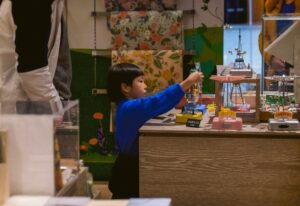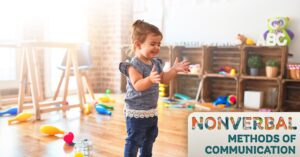Have you ever visited a foreign country and were unable to communicate with the people there because of a language barrier? While one method of communication (verbal) may be cut out, hand signs or body language can still go a long way toward communicating what you’re trying to say.
Now, imagine that all these non-verbal methods of communication weren’t an option. What would you do? Many children with autism spectrum disorder (ASD) face these challenges daily because they are unable or limited in how they can verbally and nonverbally communicate with others.
What Is Nonverbal Communication?
Think of all the different ways we communicate without even speaking a word. From crossing our arms when we’re frustrated to learning entire language systems like American Sign Language, nonverbal communication is everywhere.
Nonverbal communication is a way of sending and receiving messages without using words. Albert Mehrabian, in his book Nonverbal Communication, describes nonverbal communication as including “facial expressions, hand and arm gestures, postures, positions, and various movements of the body or the legs and feet.” He then extends his definition to include vocal phenomena and complex communication phenomena like sarcasm.
Signs Your Child May Be Nonverbal
For children growing up learning to talk and speak their needs is an important developmental milestone. However, for children with autism these skills may not come as easily.
The CDC’s Developmental Milestones say that children should be learning to speak by the end of their first year, and able to speak their needs in one to two words by two years old. If your child isn’t meeting milestones, it could be a sign to seek healthcare specialists to address your concerns.
Children with autism who are nonverbal may:
-
Not respond to their name by nine months
-
Not gesturing or responding to gestures by 18 months
-
Didn’t babble or coo as an infant
-
Using sounds or grunts as opposed to words
-
Repeating one word or phrase over and over, also known as echolalia
-
Using few words or not being able to carry a conversation after five years old
Nonverbal Communication and Autism Spectrum Disorder

For years, researchers have studied the connection between ASD and nonverbal communication. Peter Mundy, et al. conducted a study suggested that “a deficit in the development of non-verbal indicating behaviors is a significant characteristic of young children who receive the diagnosis of autism.”
According to the National Institute on Deafness and Other Communication Disorders, children with ASD often have trouble using gestures like pointing to an object and avoiding eye contact. Because they’re unable to communicate how they feel or what they need, they often show their frustration through vocal outbursts or other behaviors that may not be appropriate in a public setting.
In a study conducted by Chung-Hsin Chiang et al., titled “Nonverbal Communication Skills in Young Children,” the group tested three types of nonverbal communication skills, including joint attention, requesting, and social interaction in children with ASD compared to normally developing infants/children.
They found that “young children with autism demonstrated a pattern of deviant development in their use of different types of nonverbal communications, and a decreased frequency, above and beyond what could be explained by their general mental age.”
Despite the challenges that nonverbal children with ASD may face in communicating with others, there are a number of ways to support and better understand their needs and feelings.
How a Nonverbal Child With Autism May Communicate With Others
Nonverbal children with autism often have several methods of communicating with people. These may include:
-
Communicating through sign language or Makaton
-
Using gestures like blinking or clapping
-
Making sounds to express how they’re feeling
-
Touching a person’s face to express affection
-
Moving a person’s hand toward something they want you to focus on
How to Help a Nonverbal Child Communicate
You should seek help in addressing your child’s ability to speak to their needs. Experts all agree that early intervention has the best long-term results for children’s development. Some studies even suggest that it’s significantly harder to learn to speak after the age of five. With wait times for autism diagnoses being so long, it’s important to be proactive for your child.
Here are some ways you can help your nonverbal child communicate at home:
1. Get Involved in Play Together
By engaging in play, children develop social and communication skills in a natural and fun way. Whether it’s playing with toys, taking turns in games, or simply engaging in imaginative play. What you do doesn’t matter; just be sure it’s an activity that suits their interests and connects with them.
2. Give Them Options
To really get your child engaged with an activity, ask them about their preferences by showing them their options. Whether it’s choosing which toy to play with, what meal to eat, or picking a movie. Encourage them to tell you their choice, but provide praise even if they only gesture to what they want.
3. Use Simple Language to Describe Actions and Emotions
For example, if your child reaches for a drink, say “thirsty” as you hand it over to them. If they reach out for their favorite toy, name the toy as he or she grabs it: “doll,” “truck,” or “blocks.” If you say “no,” shake your head. If you say “yes,” noticeably nod.
4. Start on Nonverbal Communication
This can start with gesturing, eye contact, or body language. Model this behavior, using the same simple language, such as saying “happy” and smiling or pointing at an object and saying it out loud. Exaggerate your gestures and use your body and hands while communicating.
Respond to your child’s gestures: When she looks at or points to a toy, hand it to her or take the cue to play with it. Similarly, point to a toy you want before picking it up.
5. Encourage Imitation
When playing together, mimic their movements, facial expressions, and sounds. Encourage them to do the same and imitate you. This is a great way to understand body language, social cues, and paying attention.
6. Other Forms of Communication
Sometimes, no matter how much you try, a nonverbal child may still have difficulty communicating. Some children with autism do not know what they want or have the words to express their feelings and needs. For more severe cases, children with ASD can use sign language, flash cards, visual boards, or an assistive device to communicate.
7. Let Them Enjoy What They Enjoy
A lot of children with autism diagnoses enjoy repetition. Usually, the repetition is a calming way to reduce anxiety and is in no way harmful. If they enjoy it, let them do it!
These reoccurring behaviors can be repeating words or phrases (also called echolalia), watching the same movies or tv shows several times, or just doing the same activity over and over again.
ABA Therapy at Applied ABC: Helping Parents Communicate With a Nonverbal Child With ASD

Through Applied Behavior Analysis (ABA) therapy, non-verbal children are encouraged to speak rather than rely on non-verbal cues. Non-verbal cues are building blocks of communication. Just as a baby may cry to let you know they’re hungry, a child with autism might make a particular sound or grab your hand to communicate a specific need. These small cues are vital and can be used to teach language.
Click here to learn more about what ABA therapy is and how it can help children with autism learn specific skills.
Each child might be in a different place in terms of language development. Once the therapist understands where the child is at, the therapist can create a plan best suited to the child’s needs.
The ABA therapist will then use Discrete Trial Training (DTT) to teach the child sounds and words. DTT helps encourage a child to start doing the desired action. Every time they successfully use a word/sound, a child is rewarded with something they like.
For an in-depth look at what Discrete Trial Training is and how it’s used by ABA therapists at Applied ABC, read our blog.
Imitation is then used in coordination to help the children visualize the word or phrase. Pictures are also used to start associating words with items and certain acts. For many children, nonverbal communication can be overcome with positive reinforcement and practice, though some may never be able to speak at a fluent level.
Do you have a child that’s been diagnosed with autism and are looking for a caring approach to ABA therapy? Fill out our Autism Assessment Form to get started.
Sources Cited
Chiang, Chung-Hsin, et al. Nonverbal Communication Skills in Young Children
Mundy, Peter, et al. Defining the Social Deficits of Autism: The Contribution of Non-Verbal Communication Measures
National Institute of Deafness and Other Communication Disorders. Autism Spectrum Disorder: Communication Problems in Children




